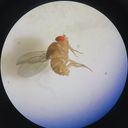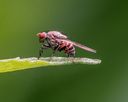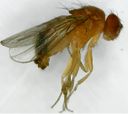Laboratory Fruit Fly
Drosophila melanogaster
Classification
- Phylum: Arthropoda
- Subphylum: Hexapoda
- Class: Insecta
- Order: Diptera
- Superfamily: Ephydroidea
- Family: Drosophilidae
- Subfamily: Drosophilinae
- Genus: Drosophila
- Species: melanogaster
Pronunciation
How to pronounce Drosophila melanogaster: /dɹoʊˈsɒfɪlə mɛləˌnoʊˈɡæstər/
These audio files are automatically generated. While they are not always 100% accurate, they are a good starting point.
Images






Summary
Drosophila melanogaster, or the laboratory fruit fly, is a significant model organism used in genetics and developmental biology research, known for its rapid life cycle and historical contributions to biological science.
Physical Characteristics
Female fruit flies are larger than males, with bodies up to 30% larger. Wild type fruit flies are yellow-brown with brick-red eyes and transverse black rings across the abdomen. Males have a cluster of spiky hairs (claspers) surrounding their reproductive parts. Wild type eyes are due to two pigments: xanthommatin (brown) and drosopterins (red).
Identification Tips
Can be distinguished by the following features: gena ~1/10 diameter of eye at greatest vertical height; male protarsus with one row of ~12 setae forming a sex comb; male epandrial posterior lobe small and nearly triangular; female abdominal tergite 6 has a dark band running to its ventral margin.
Habitat
Attracted to rotting fruit and fermenting beverages, found in orchards, kitchens, and pubs.
Distribution
Originally an African species, now distributed across all continents including islands.
Diet
Feeds primarily on decomposing fruit and microorganisms associated with fermentation.
Life Cycle
Lifespan of about 50 days under optimal conditions; life cycle includes four stages: embryo, larva, pupa, and adult. Development time varies with temperature, shortest at 28 °C.
Reproduction
Females lay around 400 eggs at a time into suitable material such as rotting fruit. Mating results in sperm storage in females, allowing for competitive fertilization among multiple males.
Ecosystem Role
Common pest in homes; plays a role in biotechnology and genetic studies.
Economic Impact
Serves as a model organism in research leading to significant scientific advancements.
Cultural Significance
Widely studied in genetics and developmental biology; awarded six Nobel Prizes since 2017 for research involving D. melanogaster.
Collecting Methods
- Use of traps baited with fruit or fermenting materials
Preservation Methods
- Freezing
- Ethanol preservation
Evolution
Previously purely an African species; genetically influenced by human-associated environments leading to its spread worldwide.
Similar Taxa
Misconceptions
Commonly mistaken as pests; however, Drosophila melanogaster inhabits rotting fruit rather than causing fruit to rot.
Tags
- fruit fly
- Drosophila melanogaster
- model organism
- genetics
- biological research